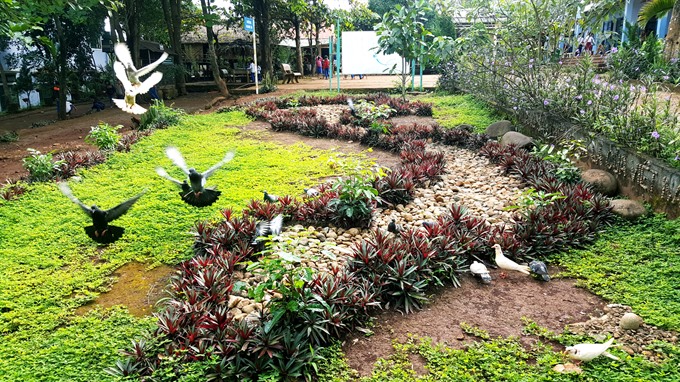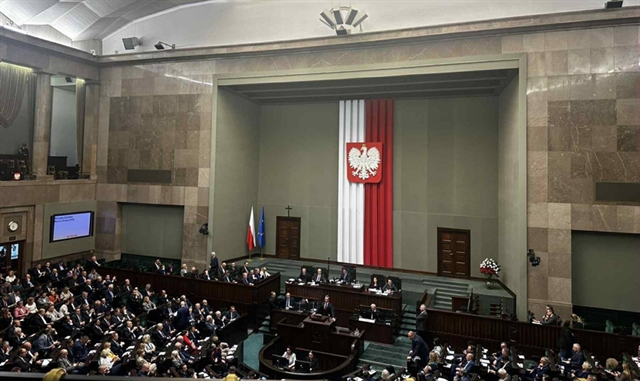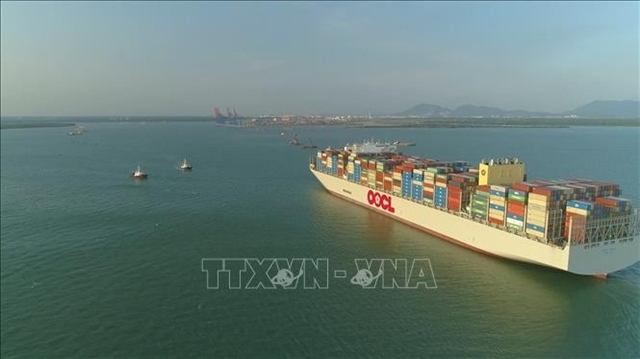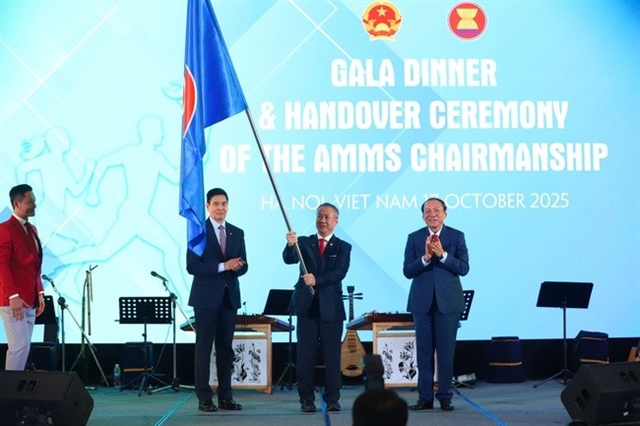

A remote school in the mountains has a special way of bringing things to life. Students at the Hướng Phùng Primary School do not need to rely only on textbooks. They can also see displays of important things at their school.
 |
| Little country: The map of Việt Nam, made of pebbles and flowers, is a popular destination for the students during break. Photo courtesy of Hướng Phùng Primary School |
A remote school in the mountains has a special way of bringing things to life.
Students at the Hướng Phùng Primary School do not need to rely only on textbooks.
They can also see displays of important things at their school.
Among them are an old guerrilla war tunnel and a traditional stilted house.
by Lương Thu Hương
Students of the Hướng Phùng Primary School learn about history and culture not only in their textbooks but also through lively replicas installed in the school premises.
Entering the mountainous school, located in a remote area in the central province of Quảng Trị, is like stepping into a mini museum.
There are eight impressive replicas on the 1,000sq.m premises, which help students visualise both national and local culture and history. The replicas include the sovereignty landmark on the Trường Sa Island in the central province of Khánh Hòa, Gạc Ma Island, Việt Nam’s map, a picture of Saint Gióng, the Vịnh Mốc guerrilla warfare tunnels, President Hồ Chí Minh’s stilt house and a traditional stilt house of the Pa Kô-Vân Kiều ethnic minority.
“The idea for the models originated from the fact that a majority of the students belong to the Vân Kiều community, who lack the opportunity to travel to learn new things. They encounter many difficulties in their studies and in gaining knowledge,” says Nguyễn Mai Trọng, the school’s principle.
“Supplementing the knowledge in the textbooks, the visual models are expected to deepen the students’ understanding, in addition to nurturing their love and respect for the history and culture of their hometown as well as nation,” Trọng says, adding such models also help improve students’ interest in studies.
Besides educational purposes, the models have also beautified the area of the Hướng Phùng School, which consists of 33 classes with more than 650 students.
Awareness about national sovereignty
According to the principal, as a school located near the Việt Nam-Laos border, the highlight of its education is to impart knowledge to the students about national sovereignty of the land and islands. Therefore, the first replica to be installed was Việt Nam’s sovereignty landmark on the Trường Sa Island.
The idea for the replica was proposed in April 2015 by Trọng and it was completed five months later, with contributions from benefactors who heard about the idea on social networking sites. Every Monday, when students attend the flag salutation ceremony, the sovereignty landmark is expected to make them aware of national sovereignty.
Following the positive response of the students to the first replica, the school authorities next decided to install a picture of Việt Nam’s map. This was created from pebbles and flowers.
For weeks, both teachers and students voluntarily went to the nearby Chênh Vênh Stream on their off days to collect pebbles, and they together created the map. While small pebbles were used to form the mainland, two big stones were used to represent the Trường Sa (Spratly) and Hoàng Sa (Paracel) Islands, and purple flowers were planted around the borders of the map.
Since its installation, the map has been the favourite spot for students to visit during breaks or extra-curricular activities.
“We gather here at every break. Sometimes we play a game of questioning each other about the locations of various provinces and islands, which increases our understanding of the country,” says Hồ Văn Hùng, a fifth grade student.
The most sophisticated replicas are those of the Vịnh Mốc Tunnel System, which has been recognised as a national special heritage site, and the traditional stilt house of the Vân Kiều-Pa Kô ethnic groups.
The uneven terrain on which the school is located gave teachers the idea to build a replica of the tunnels.
The tunnels served as a strategic location on the border of the North and South Việt Nam during the American War. It was built to protect people from the intense bombings in Sơn Trung and Sơn Hà communes in Vĩnh Linh District of Quảng Trị Province in the Demilitarised Zone.
In the replica, the teachers have duplicated the original living conditions of the families who used to seek shelter in the tunnels by displaying authentic household items donated by the local people of Vĩnh Linh District.
“It is also another way of study,” Trọng says. “It does not require much explanation. The teachers only need to introduce briefly, and then by walking up and down the tunnel everyday, students will be reminded of a significant historical phase in the Demilitarised Zone.”
Preserving cultural identities
Another central point of the education system of the Hướng Phùng School is 70 per cent of whose students belong to the Vân Kiều-Pa Kô ethnic community, is contributing to the preservation of local cultural identities.
That is why the school’s managing board mobilised for the construction of the Vân Kiều-Pa Kô stilt house as one of the eight replicas. Notably, over 40 household items had been donated by the local people to be displayed in the house.
Trọng says the preservation of the replicas has encountered quite a few difficulties due to natural factors such as rain, sunshine, weed, moss or wood-eaters, but the students and teachers have always taken good care of the exhibits to preserve them for a long-term use.
He revealed that the next replica would be the wooden statue of national hero Trần Quốc Tuấn, which is expected to arouse feelings of patriotism among the students.
“It would be a grand replica of history, culture, education and spirit that has taken up significant amount of time and expenses,” Trọng says, adding the construction of the statue has received the support of several benefactors and is expected to be completed before the start of the new academic year. VNS
GLOSSARY
Students of the Hướng Phùng Primary School learn about history and culture not only in their textbooks but also through lively replicas installed in the school premises.
Textbooks are printed books that are used to follow an academic course.
A replica of something is a copy of that thing.
A premises is a property.
There are eight impressive replicas on the 1,000sq.m premises, which help students visualise both national and local culture and history.
To visualise means to imagine.
The replicas include the sovereignty landmark on the Trường Sa Island in the central province of Khánh Hòa, Gạc Ma Island, Việt Nam’s map, a picture of Saint Gióng, the Vịnh Mốc guerrilla warfare tunnels, President Hồ Chí Minh’s stilt house and a traditional stilt house of the Pa Kô-Vân Kiều ethnic minority.
Sovereignty means the authority to rule one’s own land.
Guerrilla warfare is warfare that involves fighting in small groups, usually against a bigger army.
A stilt house is a house built way above the ground, on poles called stilts.
“Supplementing the knowledge in the textbooks, the visual models are expected to deepen the students’ understanding, in addition to nurturing their love and respect for the history and culture of their hometown as well as nation,” Trọng says, adding such models also help improve students’ interest in studies.
Supplementing means “adding to”.
Nurturing means caring and protecting.
According to the principal, as a school located near the Việt Nam-Laos border, the highlight of its education is to impart knowledge to the students about national sovereignty of the land and islands.
The principal of a school is the head teacher of the school.
To impart knowledge means to share knowledge.
The idea for the replica was proposed in April 2015 by Trọng and it was completed five months later, with contributions from benefactors who heard about the idea on social networking sites.
To propose something means to put it forward as an idea.
Contributions are things people give.
Benefactors are people whose lives become better because of receiving contributions.
Every Monday, when students attend the flag salutation ceremony, the sovereignty landmark is expected to make them aware of national sovereignty.
Salutations means greeting with respect.
This was created from pebbles and flowers.
Pebbles are little stones.
For weeks, both teachers and students voluntarily went to the nearby Chênh Vênh Stream on their off days to collect pebbles, and they together created the map.
To do something voluntarily means to do it without expecting any pay.
Since its installation, the map has been the favourite spot for students to visit during breaks or extra-curricular activities.
Extra-curricular means not part of the course that is being studied but possibly nonetheless useful.
“We gather here at every break. Sometimes we play a game of questioning each other about the locations of various provinces and islands, which increases our understanding of the country,” says Hồ Văn Hùng, a fifth grade student.
To gather, in this case, means to come together.
The most sophisticated replicas are those of the Vịnh Mốc Tunnel System, which has been recognised as a national special heritage site, and the traditional stilt house of the Vân Kiều-Pa Kô ethnic groups.
Sophisticated means smart.
The uneven terrain on which the school is located gave teachers the idea to build a replica of the tunnels.
Uneven terrain is uneven ground.
It was built to protect people from the intense bombings in Sơn Trung and Sơn Hà communes in Vĩnh Linh District of Quảng Trị Province in the Demilitarised Zone.
Intense bombing would involve many bombs dropping over a small area in a short time.
In the replica, the teachers have duplicated the original living conditions of the families who used to seek shelter in the tunnels by displaying authentic household items donated by the local people of Vĩnh Linh District.
Authentic means real.
Donated means given.
Another central point of the education system of the Hướng Phùng School is 70 per cent of whose students belong to the Vân Kiều-Pa Kô ethnic community, is contributing to the preservation of local cultural identities.
Preservation is about keeping things going.
That is why the school’s managing board mobilised for the construction of the Vân Kiều-Pa Kô stilt house as one of the eight replicas.
To mobilise means to get things ready to go into action.
Trọng says the preservation of the replicas has encountered quite a few difficulties due to natural factors such as rain, sunshine, weed, moss or wood-eaters, but the students and teachers have always taken good care of the exhibits to preserve them for a long-term use.
Exhibits are displays.
He revealed that the next replica would be the wooden statue of national hero Trần Quốc Tuấn, which is expected to arouse feelings of patriotism among the students.
Reveal means to give out information that not many people know about.
Patriotism is a sense of being loyal to your country.
WORKSHEET
State whether the following sentences are true, or false:
© Duncan Guy/Learn the News/ Viet Nam News 2018
1. True; 2. True; 3. False; 4. False; 5. True.




